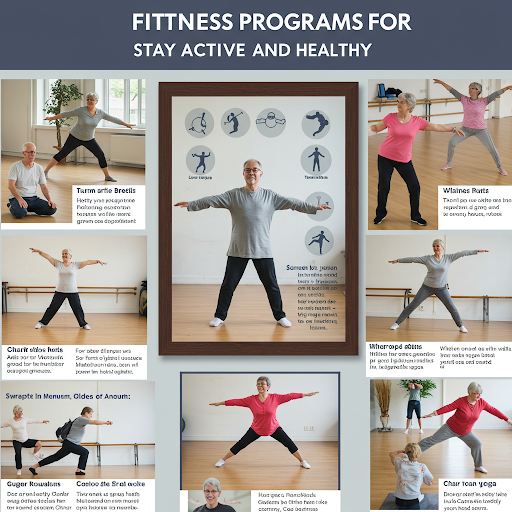Getting old gracefully does not mean slowing down. It means staying active, strong, and healthy through individualised fitness programs. Regular exercise for older adults is essential for maintaining mobility, promoting mental health, and improving overall quality of life. We will explore the top fitness programs for older adults, their benefits, and how to start safely.
Importance of Fitness for Older Adults
With age, the body undergoes natural changes—loss of muscle mass, reduced joint flexibility, and decreased balance. Older adults can counteract some of these changes through physical activity, helping to maintain independence and strength. According to the CDC, adults aged 65 years and older should engage in at least 150 minutes of moderate-intensity exercise every week, with muscle-strengthening activities on two days per week.
Fitness programs for older adults are designed to address age-related concerns, resulting in improved health. These programs focus on enhancing strength, flexibility, balance, and cardiovascular fitness—all essential for a longer, healthier life.
Advantages of Fitness Programs for Older Adults
Older adults can gain several benefits through appropriate fitness programs, including:
- Improved Mobility and Balance: Reduces fall risk—one of the leading causes of injury among seniors.
- Better Mental Health: Releases endorphins, helping alleviate anxiety and depression.
- Stronger Bones and Muscles: Helps prevent osteoporosis and sarcopenia (age-related muscle loss).
- Improved Heart Health: Supports circulation and lowers the risk of heart disease.
- Social Connection: Group programs build a sense of community, helping older adults fight loneliness.
Now, let’s explore the top senior fitness programs available.
1. Strength Training Programs
To fight muscle wasting and bone density loss, strength training is essential for seniors. It doesn’t require heavy weights—light resistance can be highly effective.
Why It’s Good for Seniors
Strength training supports daily tasks like carrying groceries, climbing stairs, and standing from a chair. It also helps prevent osteoporosis by improving bone density.
Recommended Program: SilverSneakers Classic
SilverSneakers is one of America’s best-known exercise programs for older adults, often covered by Medicare. The Classic class features:
- Light resistance with dumbbells, bands, or body weight.
- Chair-based exercises for limited mobility.
- Functional movements to ease daily activities.
How to Start
- Enroll in a SilverSneakers program in your area (gym or community center).
- Begin with light resistance workouts—1 to 2 sessions per week using 2 to 5 lbs weights or bands.
- Focus on core areas: legs, arms, back, and core.
2. Low-Impact Cardio Programs
Cardio improves heart health and endurance. Low-impact cardio is ideal for older adults because it minimizes stress on the joints.
Why It’s Good for Seniors
Low-impact cardio supports circulation, lowers blood pressure, and builds stamina—all without risking injury.
Recommended Program: Walking Groups
Walking is one of the simplest and most effective forms of cardio for seniors. Community programs include:
- Walk with Ease: Sponsored by the Arthritis Foundation, encouraging 30-minute walks, 3–5 times a week.
- Local senior center walking clubs promote both fitness and socialization.
How to Start
- Aim for 20–30 minutes of brisk walking daily.
- Wear supportive shoes to protect joints.
- Begin on flat terrain, progressing gradually to slight inclines.
3. Balance and Stability Training
Falling is a major concern for older adults. Balance training reduces fall risks significantly.
Why It’s Great for Seniors
Improved balance makes daily life safer and boosts confidence.
Recommended Program: Tai Chi
Tai Chi is a gentle martial art often called “meditation in motion.” Benefits include:
- Improved balance and coordination.
- Up to 50% reduction in fall risk.
- Enhanced mental focus and relaxation.
How to Start
- Join a local class or look for online sessions (many offer virtual options).
- Practice 2–3 times per week for 30–45 minutes.
- Begin with simple movements like “Wave Hands Like Clouds” and expand gradually.
4. Flexibility and Mobility Programs
Flexibility and mobility exercises keep joints supple and help seniors avoid stiffness common with aging.
Why It’s Great for Seniors
These programs improve joint range of motion, ease joint pain, and promote good posture.
Recommended Program: Yoga for Seniors
Chair yoga and gentle yoga are excellent for older adults. They focus on:
- Gentle stretching for flexibility.
- Breathing techniques to reduce stress.
- Modified poses for those with limited mobility.
How to Start
- Find senior yoga classes at gyms, community centers, or on YouTube.
- Practice 2–3 times per week for 20–30 minutes.
- Use props like chairs or yoga blocks for support in poses like seated forward bend and cat-cow stretches.
5. Water Fitness Programs
Water-based workouts provide resistance while reducing impact—perfect for seniors with arthritis or joint pain.
Why Water?
Water workouts offer:
- Low joint impact.
- Cardiovascular conditioning.
- Muscle toning and flexibility.
- Natural resistance that’s easy on tendons and joints.
Recommended Program: Aqua Aerobics
Aqua aerobics classes range in intensity and may include:
- Walking or running in water.
- Calf raises and squats using the pool edge.
- Resistance movements using water itself.
- Basic strokes like backstroke or breaststroke.
How to Get Started
- Check community pools or your local YMCA for aqua aerobics classes.
- Attend 2–3 sessions weekly, each lasting about 45 minutes.
- Wear water shoes for traction.
Safety Tips to Get Started
To ensure safety, seniors should:
- Consult a Doctor: Especially if you have pre-existing conditions like heart disease or arthritis.
- Start Slow: Begin with short, low-intensity sessions.
- Hydrate: Drink water before, during, and after exercise.
- Warm-Up and Cool Down: Crucial to prevent injuries.
- Listen to Your Body: Stop if you feel dizzy, short of breath, or in pain.
How to Stay Motivated
Sticking with a fitness routine can be challenging. Here are tips to stay motivated:
- Join a Group: A friendly environment can energize you.
- Set Achievable Goals: Start small and celebrate progress.
- Track Your Progress: Use apps or journals to stay on course.
- Change It Up: Mix different exercises to keep it fun and engaging.
Why 2025 Is the Year for Senior Fitness
The concept of healthy aging is rapidly growing in 2025. Seniors are more active than ever, and accessibility to programs has never been better. Virtual classes, senior-friendly gym memberships, and community outreach are all on the rise. Keywords like senior exercise programs and exercises for aging adults reflect this encouraging trend.
Conclusion: Embrace Fitness in 2025
Senior fitness programs are crucial for maintaining youthfulness, strength, and independence in later years. Whether it’s strength training, Tai Chi, or aqua aerobics, the key is to find what works for you and stick with it. The right exercise for older adults promotes not only physical well-being but also joy and social connection.
Are you ready? Start by trying a local or virtual program. For more tips on healthy aging, elderly exercise, and living an active life, explore more of our in-depth articles!







